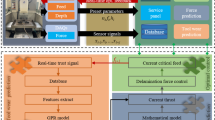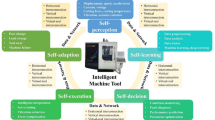Abstract
This paper aims to propose a digital twin-driven (DTD) approach that consists of the machining data (MD) in twin data (TD), design of MD acquisition methodology, construction of intelligent algorithm, real-virtual data interaction analysis and fusion technology, which improvs the predictability and management of on-line quality control of marine diesel engine (MDE) critical parts. Firstly, this paper introduces the theoretical framework of DTD on-line quality control in machining process. Secondly, we construct the process of DTD on-line quality control and introduce the digital twin model of on-line quality control based on TD-driven; the operation of data-driven quality on-line control based on digital twin including description and modeling of MD; acquisition of MD based on digital twin; TD-driven on-line tool life prediction and data fusion on-line machining parameters optimization methods. Finally, a case study is applied to validate the accuracy and availability of the DTD approach. The proposed approach provides a new way for the on-line quality control of MDE critical parts in machining process.






source heterogeneous information composition of key parts machining process














Similar content being viewed by others
References
Rabah, S., Assila, A., Khouri, E., Maier, F., Ababsa, F., et al. (2018). Towards improving the future of manufacturing through digital twin and augmented reality technologies. Procedia Manufacturing, 17, 460–467.
Liu, L., Wu, C., Zhou, Y., et al. (2011). Seismic analysis of the diesel engine emergency generator for nuclear power. Railway Locomotive and Car, 31(S1), 340–343.
Wan, R. (2013). Introduction to commodity science. Beijing, DC: Renmin University of China Press.
Li, H., Lv, Z., Xiang, Q., et al. (2012). Quality control model in textile products lifecycle and its application. Machinery Design and Manufacture, 01, 231–233.
Zhou, F. (2016). In-depth analysis and control on quality data during the process of aircraft assembly. M.A. Thesis, Sheyang: Sheyang Aerospace University.
Cheng, D. J., Xu, F., Xu, S. H., et al. (2020). Minimization of surface roughness and machining deformation in milling of AI alloy thin-walled parts. International Journal of Precision Engineering and Manufacturing. https://doi.org/10.1007/s12541-020-00366-0.
Minsu, K., Minkeon, L., Gihun, C., et al. (2020). Effect of the fiber orientation and the radial depth of cut on the flank wear in end milling of CFRP. International Journal of Precision Engineering and Manufacturing, 21, 1187–1199.
Massimo, P. A., Quirico, S. B., & Alfredo, A. A. (2014). Manufacturing quality control by means of a fuzzy ART network trained on natural process data. Engineering Applications of Artificial Intelligence, 17(1), 83–96.
Wang, D. (2011). Robust data-driven modeling approach for real-time final product quality prediction in batch process operation. IEEE Transactions on Industrial Informatics, 7(2), 371–377.
Zhao, C., Wang, F., Mao, Z., et al. (2010). Quality prediction based on phase-specific average trajectory for batch processes. Aiche Journal, 54(3), 693–705.
Zhou, S., Sun, B., & Shi, J. (2006). An SPC monitoring system for cycle-based waveform signals using Haar-transform. IEEE Transactions on Automation Science and Engineering, 3(1), 60–72.
Zhong, Y. C., Il, H. A., & Seung, K. M. (2017). Process monitoring and inspection systems in metal additive manufacturing: status and applications. International Journal of Precision Engineering and Manufacturing-Green Technology, 04(02), 235–245.
Insun, S., Junmin, L., Jun, Y. L., et al. (2018). A framework for prognostics and health management applications toward smart manufacturing systems. International Journal of Precision Engineering and Manufacturing-Green Technology, 05(04), 535–554.
Wu, S. X. (2012). Simultaneous process mean and variance monitoring using wavelet transform and probabilistic neural network. Applied Mechanics & Materials, 157–158, 11–15.
Tannock, J. D. T. (2003). A fuzzy control charting method for individual. International Journal of Production Research, 41(5), 1017–1032.
Dong, H. K., Thomas, J. Y. K., Xin, L. W., et al. (2018). Smart machining process using machine learing: a review and perspective on machining industry. International Journal of Precision Engineering and Manufacturing-Green Technology, 05(04), 555–568.
APRISIO. (2014). Digital twin: manufacturing excellence through virtual factory replication. Resource document. DELMIA APRISO. Retrieved 28, October 2019, from https://www.apriso.com.
Grieves, M. J. (2011). Virtually perfect: Driving innovation and lean products through product lifecycle management. Cocoa Beach, FL: Space Coast Press.
Grieves, M., & Vickers, J. (2017). Digital twin: Mitigating unpredictable, undesirable emergent behavior in complex system. Transdisciplinary Perspectives on Complex Systems. https://doi.org/10.1007/978-3-319-38756-7_4.
Malik, A. A., & Bilberg, A. (2018). Digital twins of human robot collaboration in a production setting. Procedia Manufacturing, 17, 278–285.
Bereqi, R., Szaller, A., & Kadar, B. (2018). Synergy of multi-modelling for process control. IFAC PapersOnLine, 51(11), 1023–1028.
Lohtander, M., Ahonen, A., Lanz, M., et al. (2018). Micro manufacturing unit and the corresponding 3D-model for the digital twin. Procedia Manufacturing, 25, 55–61.
Yu, Y., Hu, D., Dai, S., & Zhao, G. (2018). Study on application of digital twin in process planning. Aeronautical Manufacturing Technology, 61(18), 26–33.
Arno, S., Tae, H. L., Maximilian, H., et al. (2020). Evaluation of industry 4.0 data formats for digital twin of optical components. International Journal of Precision Engineering and Manufacturing-Green Technology, 07, 573–584.
Zhuang, C. B., Liu, J. H., Xiong, H., et al. (2017). Connotation, architecture and trends of product digital twin. Computer Integrated Manufacturing Systems, 23(04), 753–768.
Angrish, A., Starly, B., Lee, Y.-S., & Cohen, P. H. (2017). A flexible data schema and system architecturec for the virtualization of manufacturing machines (VMM). Journal of Manufacturing Systems, 45, 236–247.
Tao, F., Cheng, J., Qi, Q., et al. (2018). Digital twin-driven product design, manufacturing and service with big data. International Journal of Advanced Manufacturing Technology, 94(9–12), 3563–3576.
Tao, F., & Zhang, M. (2017). Digital twin shop-floor: a new shop-floor paradigm towards smart manufacturing. IEEE Access, 5(99), 20418–20427.
Tao, F., Cheng, Y., Cheng, J. F., et al. (2017). Theories and technologies for cyber-physical fusion in digital twin shop-floor. Computer Integrated Manufacturing Systems, 23(8), 1603–1611.
Tao, F., Liu, W. R., Liu, J. H., et al. (2018). Digital twin and its potential exploration. Computer Integrated Manufacturing Systems, 24(01), 1–18.
Zheng, X. H., & Zhang, J. (2019). Application of digital twin technology in textile intelligent factory. China Textile Leader, 03, 37–41.
Bao, J. S., Guo, D. S., Li, J., et al. (2018). The modeling and operations for the digital twin in the context of manufacturing. Enterprise Information Systems, 13, 534–556. https://doi.org/10.1080/17517575.2018.1526324.
Schleich, B., Anwer, N., Mathieu, L., et al. (2017). Shaping the digital twin for design and production engineering. CIRP Annals-Manufacturing technology, 66, 141–144.
A. Detzner, M. Eigner (2018). A digital twin for root cause analysis and product quality monitoring. International design conference - Design 2018, https://doi.org/10.21278/idc.2018.0418 (pp. 1547–1558).
Lu, Y. Q., & Xu, X. (2019). Cloud-based manufacturing equipment and big data analytics to enable on-demand manufacturing services. Robotics and Computer Integrated Manufacturing, 57, 92–102.
Kyu, T. P., Donggun, L., & Sang, D. N. (2020). Operation procedures of a work-center-level digital twin for sustainable and smart manufacturing. International Journal of Precision Engineering and Manufacturing-Green Technology, 07, 791–814.
Wu, Y., Yao, L. Y., Xiong, H., et al. (2019). Qualiy control method of complex product assembly process based on digital twin technology. Computer Integrated Manufacturing Systems, 25(06), 1568–1575.
Pan, M., Tang, W., Xing, Y., et al. (2016). The layout measurement points prediction and flatness calculation for the antenna plate after welding assembly based on the RBF neural network model. Asme International Design Engineering Technical Conferences and Computers and Information in Engineering Conference. https://doi.org/10.1115/DETC2016-59041.
Noemia, G., & Ferraz, A. Q. (2011). Life prediction of cutting tool by the workpiece cutting condition. Advanced Materials Research, 223, 554–563.
Li, H. P., Jun, O. Y., & Xie, X. Y. (2018). Study of tool life prediction based on AGA-GRNN. Journal of China Gorages Univ (Natural Sciences), 40(06), 84–87.
Xu, L., Yang, D., Wang, S. L., et al. (2008). Predictin of cutting tool life based on evolutionary neural network. Computer Integrated Manufacturing Systems, 01, 167–182.
Author information
Authors and Affiliations
Corresponding author
Additional information
Publisher's Note
Springer Nature remains neutral with regard to jurisdictional claims in published maps and institutional affiliations.
Rights and permissions
About this article
Cite this article
Cheng, DJ., Zhang, J., Hu, ZT. et al. A Digital Twin-Driven Approach for On-line Controlling Quality of Marine Diesel Engine Critical Parts. Int. J. Precis. Eng. Manuf. 21, 1821–1841 (2020). https://doi.org/10.1007/s12541-020-00403-y
Received:
Revised:
Accepted:
Published:
Issue Date:
DOI: https://doi.org/10.1007/s12541-020-00403-y




